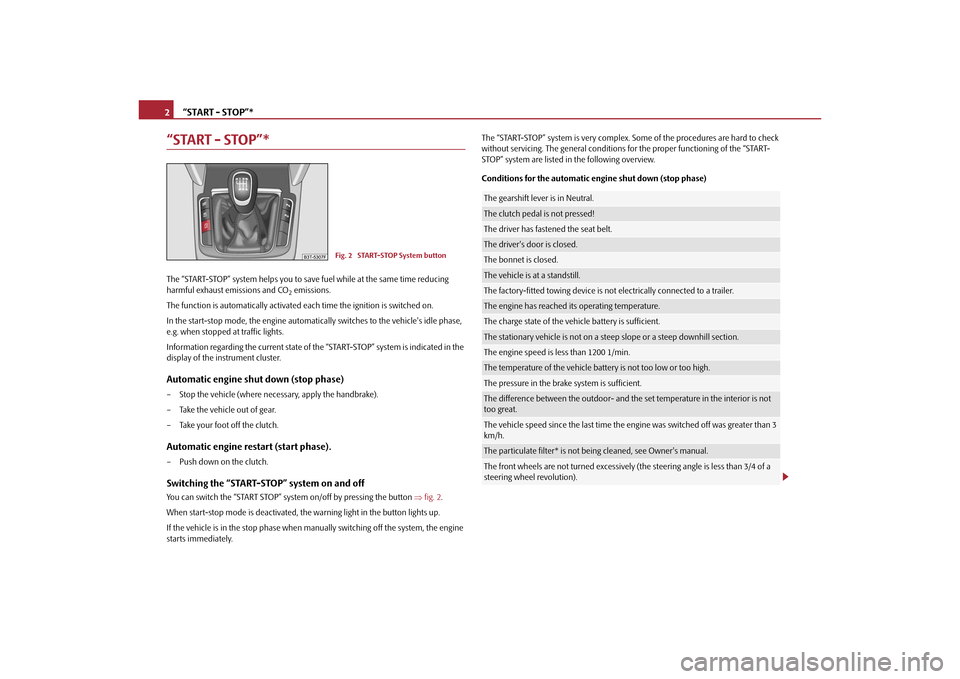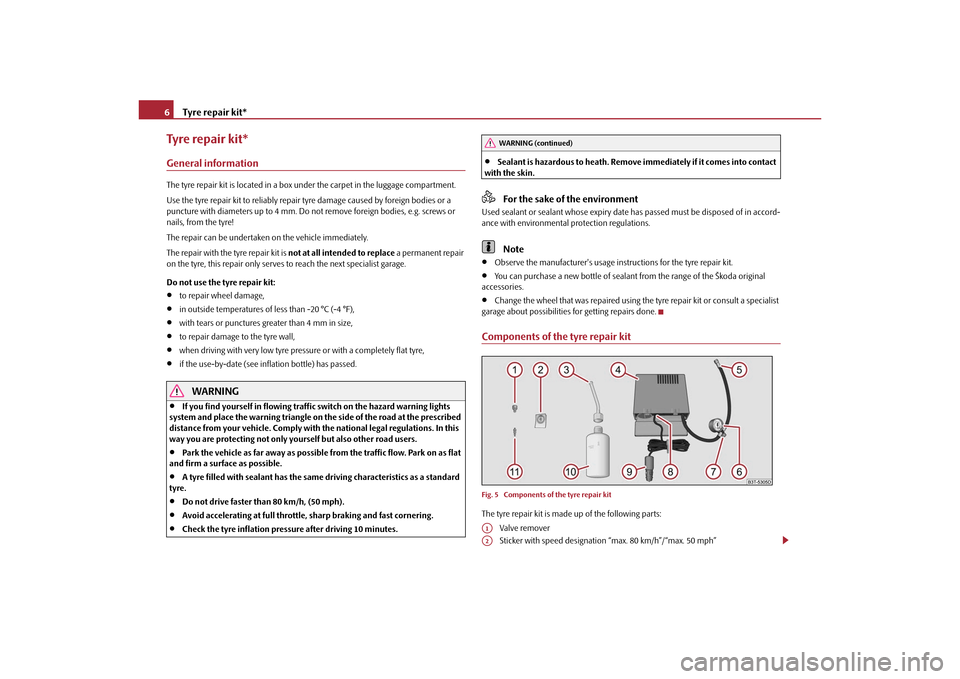wheel SKODA SUPERB 2010 2.G / (B6/3T) Technical Change
[x] Cancel search | Manufacturer: SKODA, Model Year: 2010, Model line: SUPERB, Model: SKODA SUPERB 2010 2.G / (B6/3T)Pages: 18, PDF Size: 0.76 MB
Page 3 of 18

“START - STOP”*
2
“START - STOP”*The “START-STOP” system helps you to save fuel while at the same time reducing
harmful exhaust emissions and CO
2 emissions.
The function is automatically activated ea ch time the ignition is switched on.
In the start-stop mode, the engine automatica lly switches to the vehicle's idle phase,
e.g. when stopped at traffic lights.
Information regarding the current state of th e “START-STOP” system is indicated in the
display of the instrument cluster.
Automatic engine shut down (stop phase)– Stop the vehicle (where nece ssary, apply the handbrake).
– Take the vehicle out of gear.
– Take your foot off the clutch.Automatic engine restart (start phase).– Push down on the clutch.Switching the “START-STOP” system on and offYou can switch the “START STOP” syst em on/off by pressing the button fig. 2 .
When start-stop mode is deactivated, the warning light in the button lights up.
If the vehicle is in the stop phase when ma nually switching off the system, the engine
starts immediately. The “START-STOP” system is very complex. Some of the procedures are hard to check
without servicing. The general conditions
for the proper functioning of the “START-
STOP” system are listed in the following overview.
Conditions for the automatic en gine shut down (stop phase)
Fig. 2 START-STOP System button
The gearshift lever is in Neutral.The clutch pedal is not pressed!The driver has fastened the seat belt.The driver's door is closed.The bonnet is closed.The vehicle is at a standstill.The factory-fitted towing device is not electrically connected to a trailer.The engine has reached its operating temperature.The charge state of the vehicle battery is sufficient.The stationary vehicle is not on a st eep slope or a steep downhill section.The engine speed is less than 1200 1/min.The temperature of the vehicle battery is not too low or too high.The pressure in the brake system is sufficient.The difference between the outdoor- and the set temperature in the interior is not
too great.The vehicle speed since the last time the engine was switched off was greater than 3
km/h.The particulate filter* is not being cleaned, see Owner's manual.The front wheels are not turned excessively (t he steering angle is less than 3/4 of a
steering wheel revolution).
s3lg.1.book Page 2 Monday, September 20, 2010 8:07 AM
Page 7 of 18

Tyre repair kit*
6
Tyre repair kit*General informationThe tyre repair kit is located in a box und er the carpet in the luggage compartment.
Use the tyre repair kit to reliably repair tyre damage caused by foreign bodies or a
puncture with diameters up to 4 mm. Do no t remove foreign bodies, e.g. screws or
nails, from the tyre!
The repair can be undertaken on the vehicle immediately.
The repair with the tyre repair kit is not at all intended to replace a permanent repair
on the tyre, this repair only serves to reach the next specialist garage.
Do not use the tyre repair kit:•
to repair wheel damage,
•
in outside temperatures of less than -20 °C (-4 °F),
•
with tears or punctures greater than 4 mm in size,
•
to repair damage to the tyre wall,
•
when driving with very low tyre pressure or with a completely flat tyre,
•
if the use-by-date (see inflation bottle) has passed.
WARNING
•
If you find yourself in flowing traffic switch on the hazard warning lights
system and place the warning triangle on the side of the road at the prescribed
distance from your vehicle. Comply with the national legal regulations. In this
way you are protecting not only yourself but also other road users.
•
Park the vehicle as far away as possible from the traffic flow. Park on as flat
and firm a surface as possible.
•
A tyre filled with sealant has the same driving characteristics as a standard
tyre.
•
Do not drive faster than 80 km/h, (50 mph).
•
Avoid accelerating at full throttle , sharp braking and fast cornering.
•
Check the tyre inflation pressure after driving 10 minutes.
•
Sealant is hazardous to heath. Remove immediately if it comes into contact
with the skin.For the sake of the environment
Used sealant or sealant whose expiry date has passed must be disposed of in accord-
ance with environmental protection regulations.
Note
•
Observe the manufacturer's usage instructions for the tyre repair kit.
•
You can purchase a new bottle of sealant from the range of the Škoda original
accessories.
•
Change the wheel that was repaired using the tyre repair kit or consult a specialist
garage about possibilities for getting repairs done.
Components of the tyre repair kitFig. 5 Components of the tyre repair kitThe tyre repair kit is made up of the following parts:
Valve remover
Sticker with speed designation “max. 80 km/h”/“max. 50 mph”
WARNING (continued)
A1A2
s3lg.1.book Page 6 Monday, September 20, 2010 8:07 AM
Page 8 of 18

Tyre repair kit*7
Inflation hose with plug
Compressor
Tyre inflation hose
Tyre inflation pressure indicator
Air release valve
ON and OFF switch
12 volt cable connector
Tyre inflator bottle with sealing agent
Replacement valve core
The valve remover has a slot at its lower end which fits into the valve core. This is
the only way in which you can remove and re-i nstall the valve core from the tyre valve.
The same also applies to the replacement valve core .
Preparing to use the tyre repair kitBefore using the tyre repair kit, carry out the following preparatory work:
– Park the vehicle as far away as possible from the traffic flow. Park on as flat and firm
a surface as possible.
–Have all the occupants get out. While changing a wheel, the occupants of the
vehicle should not stand on the road (instead of behind a crash barrier).
– Switch off the engine and engage 1st gear or if your vehicle is fitted with an auto-
matic gearbox, position the selector lever into position P .
– Apply the handbrake firmly.
– Check whether you can carry out the repairs with the tyre repair kit page 6,
“General information”.
– If a trailer is coupled, uncouple it.
– Remove the tyre repair kit from the luggage compartment.
– Stick the sticker page 6, fig. 5 on the dash panel in view of the driver.
– Do not remove the foreign body, e.g. screw or nail, from the tyre.
– Unscrew the valve cap. – Use the valve remover to remove the valve core and place it down on a clean
surface.
Seal and inflate tyresSealing tyres– Forcefully shake the tyre inflator bottle page 6, fig. 5 several times.
– Firmly screw inflation hose onto the tyre inflator bottle in a clockwise direction . The film on the cap is pierced automatically.
– Remove the plug from the inflation hose and plug the open end fully into the tyre valve.
– Hold the bottle with the floor facing upwards and fill the whole sealing agent in the tyre inflator bottle into the tyres.
– Remove the empty tyre inflator bottle from the valve.
– Screw the valve core back into the tyre valve using the valve remover .Pumping up the tyres– Screw the tyre inflation hose page 6, fig. 5 of the air compressor firmly onto
the tyre valve.
– Check whether the air re lease valve is closed.
– Start the engine and run it in idle.
– Plug the cable connector into the 12 Vo lt socket in the vehicle, see Owner's
manual.
– Switch on the air compressor with the ON and OFF switch .
– Allow the air compressor to run until reachi ng a pressure of 2.0 - 2.5 bar. Maximum
run time of 8 minutes !
– Switch off the air compressor with the ON and OFF switch.
– If you cannot reach an air pressure of 2.0 – 2.5 bar, unscrew the tyre inflation hose from the tyre valve.
A3A4A5A6A7A8A9A10A11
A1
A11
A2
A1
A10
A3
A10
A3
A10
A1
A5
A7
A9
A8
A5
s3lg.1.book Page 7 Monday, September 20, 2010 8:07 AM
Page 11 of 18

Technical Data
10
DimensionsDimensions (mm)Max. permissible gross weight per axleMax. permissible gross weight per axle (in kg) - front/rear axle
Superb
Superb GreenLine
Combi
Combi GreenLine
Length
4838/4849
a)
a)The value corresponds to the status with visual appearance package.
4838/4849
a)
4838/4849
a)
4838/4849
a)
Width
1817
1817
1817
1817
Width including exterior mirror
2009
2009
2009
2009
Height
1462/1482
b)/1447
c)
b)The value corresponds to the status with rough road package.c)The value corresponds to the status with sport chassis.
1464/1449
c)
1510/1529
b)/1497
c)/1495
d)
d)The value corresponds to the status with sport chassis - valid for vehicles with 3.6 ltr./191 kW FSI engine.
1511/1496
c)
Clearance
139/158
b)/123
c)
140/125
c)
141/159
b)/127
c) /126
d)
141/126
c)
Wheel base
2761
2761
2761
2761
Track gauge front/rear
1545/1518
1537/1510
e)
e)Valid for vehicles with 3.6 ltr./191 kW FSI engine.
1545/1521
1545/1517
1537/1510
e)
1545/1521
Petrol engines
Superb
Combi
1.4 ltr./92 kW TSI
1010/1040
1010/1060
1.8 ltr./118 (112) kW TSI - M6
1040/1040
1040/1060
1.8 ltr./118 (112) kW TSI - DQ7
1060/1030
1060/1060
1.8 ltr./118 (112) kW TSI - 4x4
1080/1090
1080/1110
2.0 ltr./147 kW TSI
1090/1040
1080/1070
3.6 ltr./191 kW FSI
1150/1140
1150/1160
Diesel engines
Superb
Combi
2.0 ltr./103 kW TDI CR DPF - M6
1080/1040
1080/1060
2.0 ltr./103 kW TDI CR DPF - DQ6
1100/1040
1100/1060
2.0 ltr./125 kW TDI CR DPF - M6
1090/1040
1090/1060
2.0 ltr./125 kW TDI CR DPF - DQ6
1110/1040
1100/1060
2.0 ltr./125 kW TDI CR DPF - 4x4
1120/1090
1120/1110
s3lg.1.book Page 10 Monday, September 20, 2010 8:07 AM